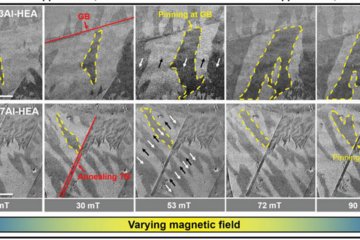All genres
101.
Talk
An integrated crystal plasticity and phase field model to simulate twinning behavior in magnesium. Euromat 2017, Thessaloniki, Greece (2017)
102.
Talk
On the importance of using 3D microstructures in Crystal Plasticity Simulations. Symposium: 3D materials characterization at all length scales and its applications to iron and steel, Düsseldorf, Germany (2017)
103.
Talk
Strain Partitioning in Metallic Microstructures: The Importance of Considering the 3D Morphology. BSSM's 12th International Conference on Advances in Experimental Mechanics, University of Sheffield, Sheffield, UK (2017)
104.
Talk
DAMASK - Düsseldorf Advanced Material Simulation Kit. 7th MaDIS open seminar, National Institute for Materials Science, Tsukuba, Japan (2017)
105.
Talk
An integrated crystal plasticity-phase field approach to locally predict twin formation in magnesium. DGM Meeting, "Herausforderungen bei der skalenübergreifenden Modellierung von Werkstoffen ", Regensburg, Germany (2017)
106.
Talk
Thermo mechanically coupled simulation of high manganese TRIP/TWIP Steel. 5th International Conference on Material Modeling, ICMM 5, Rome, Italy (2017)
107.
Talk
Crystal Plasticity Simulations on Real Data: Towards Highly Resolved 3D Microstructures. MRS Spring Meeting 2017, Phoenix, Arizona, USA (2017)
108.
Talk
Predicting Materials Strength in BCC Alloys using parameter-less mesoscale approaches. MRS Spring Meeting 2017, Phoenix, AZ, USA (2017)
109.
Talk
Deformation in polycrystals: Theory, implementation, and application of crystal plasticity. Seminar des Instituts für technische Mechanik, TU Clausthal, Clausthal, Germany (2017)
110.
Talk
Coupling Phase-Field and Crystal-Plasticity Simulations. Plasticity 2017, 23rd International Conference on Plasticity, Damage & Fracture 2017, Puerto Vallarta, Mexico (2017)
111.
Talk
DAMASK - the Düsseldorf Advanced Material Simulation Kit Engineering of Advanced Materials. "Engineering of Advanced Materials: Numerische Optimierung basierend auf Vorhersagemodellen" Meeting, Erlangen, Germany (2016)
112.
Talk
From Phenomenological Descriptions to Physics-based Constitutive Models EPSRC Workshop on Multiscale Mechanics of Deformation and Failure in Materials. EPSRC Workshop on Multiscale Mechanics of Deformation and Failure in Materials
, Aberdeen, Scotland (2016)
113.
Talk
From micromechanics to component scale behavior. DGM AK Mikrostrukturmechanik, Aachen, Germany (2016)
114.
Talk
Von der Mikromechanik zum Bauteilverhalten. Trend-Workshop Dualphasenstahl, Bochum, Germany (2016)
115.
Talk
Crystal plasticity study of monocrystalline stochastic honeycombs under in-plane compression. 8th International Conference on Multiscale Materials Modeling, MMM2016, Dijon, France (2016)
116.
Talk
Unraveling the temperature dependence of the yield strength of tungsten single crystals using atomistically-informed crystal plasticity. 8th International Conference on Multiscale Materials Modeling, MMM2016, Dijon, France (2016)
117.
Talk
Unraveling the temperature dependence of the yield strength in BCC metals from atomistically-informed crystal plasticity calculation. Dislocations 2016, Purdue University, West Lafayette, IN, USA (2016)
118.
Talk
Using the Spectral Solver. 5th International Symposium on Computational Mechanics of Polycrystals, CMCn 2016 and first DAMASK User Meeting, Düsseldorf, Germany (2016)
119.
Talk
Crystal Plasticity Simulations on Real Data: Towards Highly Resolved 3D Microstructures. 26th International Workshop on Computational Mechanics of Materials - IWCMM 26, Tomsk, Russia (2016)
120.
Talk
Spatially Resolved Through-Process Modelling. MSE 2016, Darmstadt, Germany (2016)











